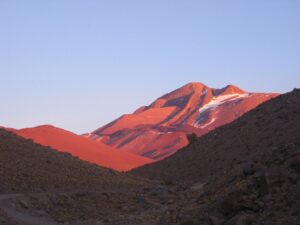
Llullaillaco during sunset, Lion Hirth (User:Prissantenbär), 2006, public domain.
The Llullaillaco is the second highest active volcano in the world, towering 22,000 ft (6,700 meters) over the Andes of Northwest Argentina, in the province of Salta near the Chilean border. It is such a beautiful and imposing peak, its steep slopes always covered with snow, that it was a sacred mountain for the ancient Inca civilization which flourished in the region. Its last recorded eruption occurred in 1877.
But in March 1999, the mummified remains of three children (one boy and two girls between six and fifteen years old) were found near the mountaintop by an international expedition. The finding had similar effects to those of a volcanic eruption: never before had the Argentine public had the chance to look so closely at its Inca past and to realize how closely related it was to the country’s indigenous origins: to many people, the Inca empire was geographically distant, centered in Perú and too far removed from Argentina’s pre-Colonial history.
Public interest was perhaps also aroused by the fact that it was the first real evidence that human sacrifices had ever taken place during the Inca control of part of the Argentine Northern territory. The victims’ young age also added to the impact.
The three children belonged to a native group forming part of the powerful Inca empire, the largest political unit in the Americas during pre-Columbian times. The empire remained in existence until 1572, when it fell to Spanish hands. While centered in Perú (where its capital, today’s Cuzco, was located) it extended to cover vast extensions in the Argentine Northwest, most of Bolivia and Northern Chile. According to researchers, the children were natives from Cuzco and had to travel for approximately six months to reach their final (and fatal) destination.
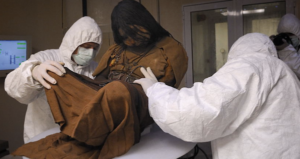
Conservation of the mummy of The Maiden, Museo de Arqueologia de Alta Montana de Salta, Secretaria de Cultura, Gobierno de Salta
The children were found near the Llullaillaco mountaintop, in full regalia, with silver jewelry, feather headdresses and stone adornments. After being put to sleep with a mixture of alcoholic beverages and drugs, they had been placed in a small room and left to die there. Around 150 objects were found along with them, including gold and silver statuettes, textiles, and pottery. Their discovery constitutes the highest archeological site in the world.
According to researchers, the three children were sacrificed between 1480 and 1532 as a human offering seeking the favor of the Sun God. Thanks to the extreme low temperatures in the Llullaillaco peak, their bodies were extremely well preserved.
Never before had Argentina’s (or for that matter, South America’s) archaeological research faced a similar challenge and opportunity and produced so many interesting results. Many scientific teams have examined the mummies, which, according to some sources, are the best preserved ones ever found. The research has widened the knowledge of the Inca civilization (or at least of its population in what is now Argentina) to extremes never reached before.
With extreme care, the three bodies were taken to a research facility of the Catholic University of Salta and later, in 2007, to a provincial public facility specifically designed and built to preserve the mummies, the Museo Arqueológico de Alta Montaña (or MAAM) in the very center of the city of Salta. The museum has twice received TripAdvisor’s Traveller’s Choice Award. The mummies are preserved there at a constant temperature of 20 ° Celsius (-4° Fahrenheit), under UV filtered light and in a low oxygen environment. The public has given them their popular names: “The Lightning Girl”, “The Maiden” and “The Boy”.
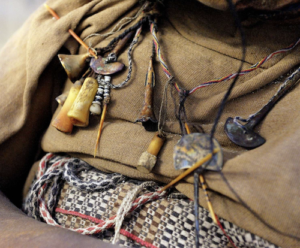
Beads and pendants decorating the breast of the Maiden, Llullaillaco mummies, Museo de Arqueologia de Alta Montana de Salta, Secretaria de Cultura, Gobierno de Salta.
Shortly before the transfer of the three children to Salta, researchers had found another mummy in Quehar, a nearby funeral site. In a desperate race against tomb raiders (which, in a last ditch effort to steal it, tried to extract the body with dynamite) researchers were able to relocate it in Salta. Although now also preserved at the MAAM, the mummy is not exhibited due to its bad state of preservation.
In 2001 Argentina’s Congress enacted a statute declaring the three mummies “national historic property” and the Llullaillaco “a national historical site”. While these decisions carry little economic consequences, they do grant a favorable legal status preventing the sites from being devoted to non-scientific activities.
Earlier this year, however, the National Indigenous Institute (which normally takes care of settling land claims by local native groups) declared the Llullaillaco “a sacred Inca site”. This prompted some private institutions, claiming that their members were part of the native Inca population, to request that the mummies be returned to their original burial site.
In the past, whenever similar claims took place in Argentina and human remains were transferred to “sacred sites” from small local museums where they were being exhibited, they quickly disappeared. In addition, many other sites like Llullaillaco existed along the Andes but all of them appear to have been looted before whatever they contained could be adequately identified and preserved.
The request by native groups was made public last July. On September 26, 2022, La Nación, one of the two major Spanish-language Argentine newspapers, founded in 1870, published an editorial on the matter, titled “Towards a cultural catastrophe”[1].
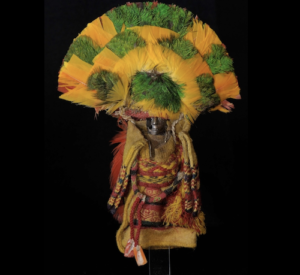
Ceremonial object found with Llullaillaco mummies, Museo de Arqueologia de Alta Montana de Salta, Secretaria de Cultura, Gobierno de Salta.
The editorial mentioned that when ineptitude and ignorance become the basis for governemental acts, the results are never good for society. There are also bad consequences of public decisions which, disguised as harmless measures or mere political statements or under the excuse of protecting public interests, hide ignoble intentions. But even worse are those governmental acts which are the result of all the above: apparently harmless decisions are issued at the request of people who, acting behind the scenes, pursue unspeakable purposes. It also stressed that this is a common situation in Argentina: the handling of complex problems is given to clumsy or ignorant public officials who, to make things worse, frankly ignore the monetary motivations of people who appear to be engaged in worthy activities only to obtain illegal economic profits. In those cases the results end up in a disaster. If there was a serious problem, an even worse one is created.
Even when the above description applies to all aspects of Argentine institutional life, La Nación indicated that something similar had recently occurred with the recent comings and goings in connection with the declaration of the Lanin volcano as a sacred site of the Mapuche indians by the National Park Administration. The matter was apparently well settled.
“But things are not going well with a similar and recent declaration issued by the National Indigenous Affairs Institute (INAI) affecting the Llullaillaco volcano in Salta” said La Nación.
“The human remains and funerary objects [found at the Llullaillaco] are preserved, researched and presented to the public in a specially built museum in Salta where state-of-the-art cryoconservation techniques (considered to be among the most advanced in the world) and international protocols regarding the preservation of human remains are applied. The museum is not only visited by many tourists but also by a great number of scientists from all over the world, who consider “the Llullaillaco treasury” a highly valuable source of information”.
“On June 2001, by act of Congress, the bodies of the three children were declared “national historic assets” and the volcano’s summit a “historic place”; that is, part of the historical heritage of (and for the benefit of) all Argentines and not of a single group or social sector. Since they were found, the three children’s mummies (as it happened in the rest of the world in similar circumstances) have provoked fiery controversies and arguments about the respect they deserve, the destination to be given to them and the treatment they receive as human remains”.
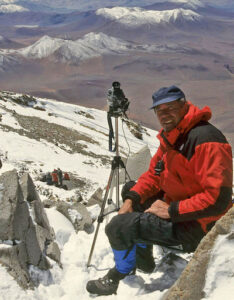
Johan Reinhard during the rescue of the Inca mummies in 1999. Reinhard is an Explorer-in-Residence at the National Geographic Society. Wikimedia Commons, Photo Johan Reinhard.
“Now, as soon as the Llullaillaco volcano was designated as a “sacred site” by the INAI, new voices have been raised demanding that the three children be returned to the mountain, along with their attire and clothing.”
“Similar cases have already occurred in Argentina. In 2012, the remains of more than fifty Tehuelche indigenous people kept at the Governor Tello Museum in Viedma were relocated and buried in a cemetery outside that city, later declared a “sacred site” by the INAI”.
La Nación also pointed out that in the inextricable bureaucratic lingo, full of politically-charged images (when not begging the question), designation of a location as a “sacred site” implies “defining and protecting the common territorial space which constitutes the key underlying layer of the construction of an identity and of the reproduction of the communal social relationships of the indigenous communities populating the relevant region and making use of its territory”.
The editorial indicated that it was not worthwhile to enter into a philosophical argument as to whether an “identity construction” may exist without an indispensable “key underlying layer” formed by a “common territorial space” provided by the government. But surely its readers wondered whether many immigrants to Argentina (who, among other things, filled the Pampas with theaters and auditoriums) may help with the answer.
La Nación also said that “now the matter is much more serious, because a wrong decision (under the false pretense of an alleged desecration) may destroy the remains of the ancestors of a large segment of the population of the Argentine Northern provinces and raze to the ground important anthropological and archaeological investigations being carried out about the common past of all Argentines”.
It also explained that “Mankind’s cultural and spiritual heritage is revealed to us through many elements, both tangible and intangible. Among them are the remains of our common ancestors. The scientific and cultural interest they arouse is not new, but it is not easy to make it compatible with the respect they deserve. The matter is even more complex when the argument of a possible exclusive —and discriminatory— ownership over those remains by a particular social or ethnic group is put forward”.
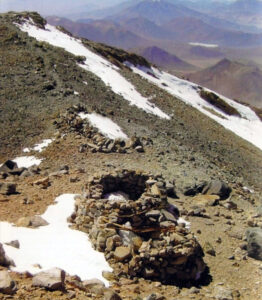
Archaeological site, double huts on the secondary crest of Llullaillaco, Argentine monument ID 838, photo by Christian Vitri, 7 April 2012, CCA-SA 3.0 Unported license.
According to the newspaper, “the defense of mankind’s common heritage requires us to bear in mind that it is formed by the particular features and cultural background of many social groups and communities who also deserve that their respective traditions be protected, respected and preserved. Among those groups there are many who, throughout their history, suffered discrimination, were subject of colonization processes and forced evictions or were victims of the destructive eagerness of their powerful enemies. That is the case, precisely, of the indigenous groups, as mentioned not only by the UN Declaration of the Rights of Indigenous Peoples (approved in September 2007) but also by the UNESCO Declaration on Cultural Diversity of November 2001 (which in particular refers to the rights of indigenous populations)”.
“Those declarations, —La Nación explained— “the explicit purpose and intention of which are the preservation of the cultural values of indigenous or minority groups and not their disappearance by negligence or neglect due to their illegal trade, are exactly those quoted in Argentina by those who claim to defend those groups by requesting unnecessary “repatriations” or “devolution to sacred sites”. It is likely that some of them, in their ignorance of the looting that would result if the bodies were put back on the Llullaillaco mountaintop, may not know that their position will inevitably lead to the disappearance of their ancestors’ human remains and, with them, the memory of their existence. And it is also possible that there may be others who know, hypocritically, that such is the road that bureaucracy must be forced to take to surrender those remains to illegal traders”.
“No one denies that, after the Llullaillaco findings, we now know much more about those who lived and died in the Argentine Northwest in ancient times than we ever knew. For several reasons, their descendants have not wanted or known how to transfer that knowledge nor have our school manuals ever served to arouse any collective or deep interest in our indigenous population. Losing that knowledge again and quashing such interest only to return the three children’s remains to the place where they were sacrificed, a place they or their families surely did not choose for their death, sounds extravagant, rudimentary and unnecessary”.

Conservation of the mummy of El Niño, Museo de Arqueologia de Alta Montana de Salta, Secretaria de Cultura, Gobierno de Salta
“There are “civilized” ways (and here that adjective is deployed in its whole semantic value) through which culture and science can address research, preservation and conservation of human remains. The most important museums in the world are governed by rigid protocols requesting and imposing the strictest respect of the mortal remains of members of the human race”.
“Certain countries may be validly accused of predatory colonial practices, of going to extremes to exhibit fellow human beings then deemed exotic, while bragging about their European ethnocentrism, according to the then world prevailing values. The values that led the three Llullaillaco children to death are also susceptible of criticism. It should also be valid to take as an example the conduct currently adopted elsewhere, precisely to set aside those vices and defects. There are rules and protocols, like the ones applied, published and reviewed by the British Museum in 2014, that show that absolute respect and the most devoted care are possible. Surely, this is preferable to lip service to a need for repatriation which, in the end, does not mean anything other than neglect and, on occasions, vandalism, destruction and desecration”.
“Respectful preservation is key at Salta’s MAAM, which, at its entrance, warns that the mummies preserved there (under strict temperature, light, humidity and sterile conditions) are our ancestors’ remains and as such deserve utmost respect”.
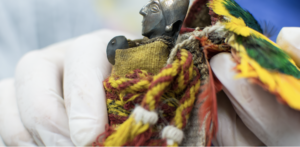
Conservation of ceremonial objects found with the mummies, Museo de Arqueologia de Alta Montana de Salta, Secretaria de Cultura, Gobierno de Salta
La Nación reminded its readers that “In two cases (one of them very recent) Argentina’s Supreme Court specifically noted the constitutional obligation of the Executive and Congress to preserve and protect our cultural heritage. The Court has not only cited the Constitution but also several statutes that leave no doubt as to the conduct that must be followed by the authorities”.
The editorial concluded by saying that “Giving back” or “returning” the Llullaillaco children to the aridity and cold of the mountaintop will be equal to abandoning them or delivering them to tomb raiders (enthusiastic allies of those who promote such returns) when, 500 years after their sacrifice and twenty generations later, there is no one with sufficient genetic or legal credentials to justify such devolution or restitution. The trace of their memories and an inexhaustible source of information about our past will be lost forever”.
[1] The original Spanish version can be found at https://www.lanacion.com.ar/editoriales/camino-a-un-desastre-cultural-nid26092022/
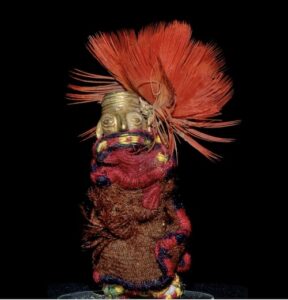
Ceremonial object found with Llullaillaco mummies, Museo de Arqueologia de Alta Montana de Salta, Secretaria de Cultura, Gobierno de Salta.
Juan Javier Negri is an Argentine lawyer practicing in Buenos Aires. He holds a law degree from the University of Buenos Aires and a Master in Comparative Law degree from the University of Illinois College of Law. He is Chairman of the Board of Trustees of Fundación Sur, an organization preserving the history and creative works of 20th. century South American writers and artists. In 2015 he received the Uría Meruéndano Art Law Award granted by the Uría Foundation (Madrid) for his book Banksy’s door: an essay on mistake and error in the purchase of artworks. In 2017 he was appointed to serve on the Board of Directors of the Fondo Nacional de las Artes, an autonomous state agency to provide financial assistance to artists and arts projects. Since January 2012, he is included in the Geneva-based WIPO List of Neutrals for Art and Cultural Heritage. He is also a member of the Court of Arbitration for the Arts, The Hague and the president of the Argentine Association of Comparative Law. He writes extensively on art law and cultural matters.
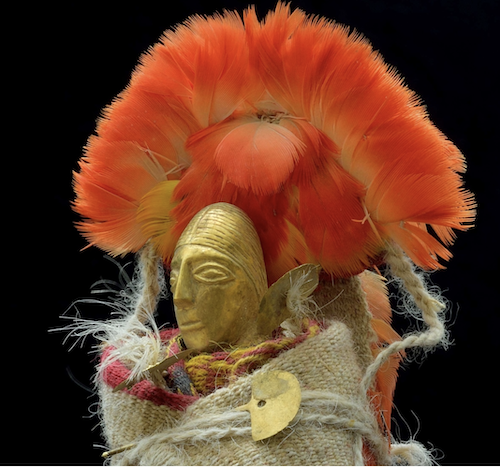 Ceremonial object found with the Llullaillaco mummies, Museo de Arqueologia de Alta Montana de Salta, Secretaria de Cultura, Gobierno de Salta.
Ceremonial object found with the Llullaillaco mummies, Museo de Arqueologia de Alta Montana de Salta, Secretaria de Cultura, Gobierno de Salta. 

